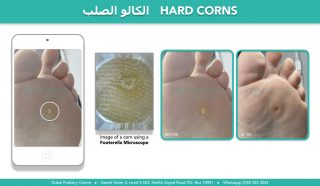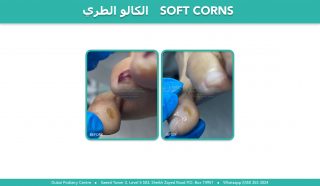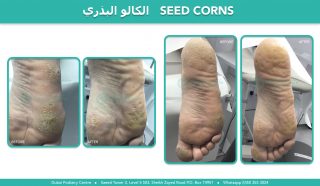Have You Got a Foot Corn? What It Is and Why It Happens
Have You Got a Foot Corn? What It Is and Why It Happens
A foot corn can develop over or under any bony prominence of the foot. Corns are a natural defence mechanism – the body’s way of protecting itself from excessive pressure and friction. There are several types of corns: hard corns, soft corns, and seed corns.
Hard Corns
Hard corns are the most common type. They often form on top of or underneath a bony area, such as the side of the little toe where shoes press tightly, or under the ball of the foot (beneath the metatarsal heads).
A hard corn is made of dense keratinised skin, very similar to a toenail, and often appears diamond-shaped. It forms to protect the underlying tissue from ulceration, acting like a natural “plug.”
However, this protective layer can become so compact and hard that it feels like a small stone or diamond under the skin and can be quite painful.

Hard corns also occur under the forefoot, particularly if:
- There is reduced fatty padding beneath the metatarsal heads.
- The transverse arch (the small arch that runs across the forefoot) has collapsed.
- When this arch collapses, the long metatarsal bones press down through the soft tissues, creating high-pressure points. The body reacts by forming hard corns to protect against skin breakdown.
Treatment for Hard Corns
- Choose better-fitting footwear to reduce pressure on the sides of the toes.
- Use custom orthotics to lift and support the metatarsal heads, redistributing pressure away from the painful area.
- It usually takes 4–6 months for the body to stop forming the excess hard skin once pressure is corrected.
Soft Corns
Soft corns develop between the toes, where moisture and friction combine. The skin here becomes macerated (soft and rubbery) due to trapped moisture, leading to a burning or acidic sensation.
This happens when the toes are pressed tightly together, and the corn cannot dry out. The buildup of body fluid in the tissue — part of the body’s defence mechanism — can make the area sore and inflamed.

Treatment for Soft Corns
- Keep the area dry and ventilated.
- Use toe separators or spacers to relieve pressure.
- Apply antifungal or drying sprays if moisture is excessive.
Seed Corns
Seed corns are tiny, clustered, and very painful. They appear as small, yellowish dots — like a sprinkle of seeds and are usually not linked to pressure points. Instead, they are related to overactive nerve endings in the skin and can sometimes run in families.

Treatment for Seed Corns
- Apply urea-based creams or softening lotions to reduce keratin buildup.
- Wear padded socks and soft, cushioned footwear to reduce sensitivity.
When to See a Podiatrist
If you have recurring or painful corns, professional treatment is important. A podiatrist can safely remove the corn, identify its cause, and create a custom orthotic solution to prevent recurrence.
Left untreated, corns can worsen or lead to ulcers, particularly for people with diabetes or neuropathy.
At Dubai Podiatry Centre, our specialists assess the exact mechanical cause of your corn.
Treatment plans include:
- Corn removal and relief of pressure areas
- Custom-made orthotics
- Footwear advice
- Moisturising or keratolytic creams
You don’t need to live with foot pain, most corns can be permanently prevented once the underlying cause is treated.
Written by Michelle Champlin, Chief Podiatrist
Dubai Podiatry Centre Experts in Foot Health and Biomechanics
For more information or to book an appointment please call our clinic +971 4 3435390 or WhatsApp +971 50 3553024

